6 Major Cases of Hollywood Ripping off Anime (and One Huge Counter-Example)
 |
“Rip off!” It’s fun little accusation to throw around, isn’t it?
These days, whenever we look over any list of forthcoming blockbusters, the default response is to bemoan the lack of originality on display. What’s up with all these sequels? Why are there so many remakes? Can a movie ever get made without being based on a comic, novel, TV show or video game? It’s enough that we excitedly treat “originals” like they’re rare and precious animals wandering onto the farm.
But how strict do we want to get about the notion of a flick “not being based on any prior material?” Well, we’re going to argue here that many memorable “original” Hollywood pictures have actually owed enough of a debt to anime that they should really have an additional “based on” credit.
Of course, we can’t act like anime hasn’t ripped American films off plenty of times (compare Dragon Ball Z‘s Saiyan Saga with Superman II if you want a laugh), and there are certainly plenty of cases where the same ideas just happen to bubble up in the zeitgeist coincidentally (for fun, contrast the blonde, grouchy, chain-smoking exorcists who inspired both Mushi-Shi and Constantine). Today, though, we’re squarely focussing on the most undeniable, laughable, and egregious imitations – ripoffs so flagrant that our frothing nerd rage prevents us from just letting it go. These are not coincidences.
1. Pacific Rim = Neon Genesis Evangelion
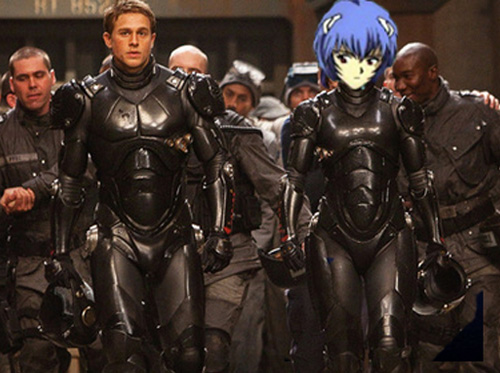 |
Everybody should know this already, but we might as well state it outright…
Sure, Pacific Rim draws upon a wide history of Japanese entertainment, paying homage to the assorted traditions of mecha, kaiju and tokusatsu (represented to English audiences, respectively, by localized titles like RoboTech, Godzilla and Power Rangers). However, any hopes of the Hollywood adaptation of Gainax Studios’ anime series Neon Genesis Evangelion finally rising out of development hell have been rather thoroughly quashed by this flick. For all intents and purposes, Pac Rim is what an American Eva would’ve looked like.
Both stories follow the same broad strokes. Young pilots with traumatic pasts are enlisted by a multinational coalition to battle waves of mysterious extradimensional giants that are appearing with increasing frequency. Big robots vs. the apocalypse is pure Evangelion. Oh wait, so is that part about syncing mentally with another human being. Shit, even the Jaeger pilots’ armors kind of look like the Eva pilots’ plug suits.
Most strikingly, Pacific Rim‘s Mako Mori seems like an amalgamation of all three major female characters from Eva. Like Asuka Langley, she’s an overachiever who’s secretly beset by serious self-confidence issues. Like Misato Katsuragi, she’s fueled by a very personal vendetta against the monsters, having watched helplessly as they killed her family when she was a kid. And even her look pays tribute to Rei Ayanami: a pixie cut with a shock of blue hair being a more modest stab at Rei’s striking blue dye job.
2. The Lion King = Kimba the White Lion
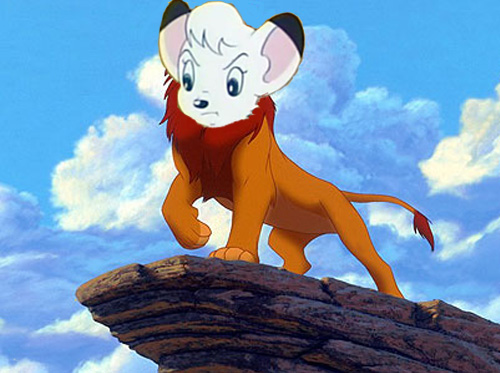 |
Go on and keep trying to claim that this is based on Hamlet, or whatever Shakespeare play sounds best that day – everybody knows the truth at this point. The Lion King is Kimba the White Lion, plus a few sassy animal sidekicks and a dash of songs about how to relax.
The similarities are so blatant, they’re almost insulting (oh, he’s Simba, not Kimba? COME ON. You’re not even trying). The iconic lion-standing-on-a-cliff shot, the even-more-iconic-talking-to-dead-dad-via-cloud shot… they’re all borrowed/traced from a brilliant dude by the name of Osamu Tezuka. Early concept paintings even include a white-furred Simba, for crying out loud!
Much like that infamous easter egg where dust spirals to spell “sex,” they say that if you squint real hard, you can also see all the corporate lawyers, lurking in the crowd shots during the “Circle of Life” number. Their arms are crossed, daring anyone to call foul on this farce.
3. Black Swan/Requiem for a Dream = Perfect Blue
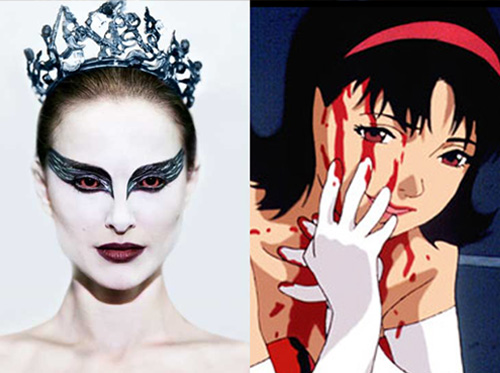 |
Hollywood can’t get enough of cribbing from the Satoshi Kon playbook (and who can blame them? The guy was brilliant), and Darren Aronofsky is possibly the most openly dedicated to such borrowing. He even went so far as to buy the rights to Perfect Blue just to exactly copy one shot for Requiem for a Dream. Sure, “girl screaming in bathtub” is a scene you may have run into before in cinema, but this is SHOT FOR SHOT.
Black Swan is the real offender here, though. Covering all the same themes – fame, loss of self, aggressive ambition, repressed sexuality, confusion about the line between fantasy and reality – it pretty much tells the same story, beat for beat. Both movies aim to give you the heeby-jeebs by roughing up a classically delicate, feminine subject with a bit of evil, murderous implication. Even their posters are eerily similar, swapping a bloodshot ballerina in for a bloodstained pop idol. With only a few details changed for American audiences, Black Swan feels so much like Kon’s work that it’d be easy to mistake it for his live-action directorial debut.
4. The Matrix = Ghost in the Shell
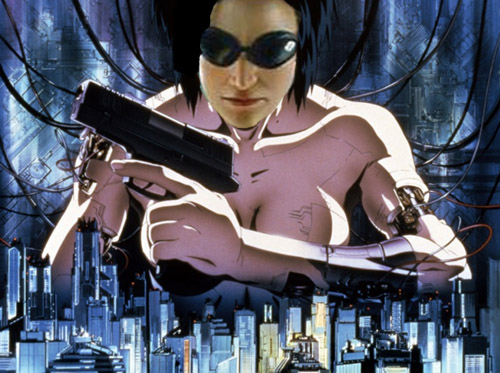 |
Yup, The Matrix was pretty much pitched as a live-action Ghost in the Shell. The Wachowskis even showed clips from the anime to studios to get the money people psyched. Especially obvious “references” include the scene where Neo runs through a city street while gunshots blast apart watermelons all around him, the general green-ness of the cinematography, and that particularly iconic computer display featuring all the green code.
Oh, and Trinity is very much in the Motoko Kusanagi “type.” As in, looks just like her, with a different haircut.
The Matrix surprised US audiences with a “new” approach to action and storytelling (which, of course, largely borrowed from anime, kung fu flicks and HK crime cinema), but the particular influence of Masumune Shirow’s world and attitude about sci-fi is pervasive. One of the cooler moments in Ghost in the Shell is when a garbage man realizes that his memories – wife… kids… his entire life, really – were fabricated by a hacker called the Puppet Master. Bam! There’s The Matrix. Right there in one scene.
5. Inception = Paprika
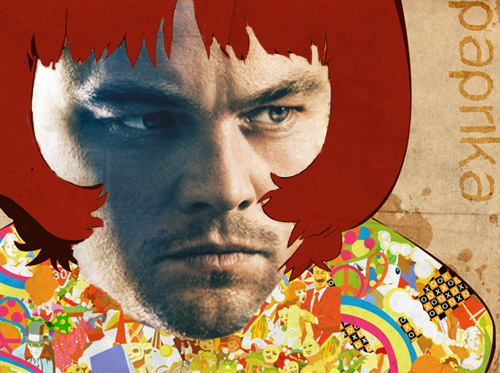 |
Let’s not mince words… these movies are damn near identical in basic concept.
Some kind of magic science exists. It lets people get up into other people’s dreams and solve their inner, psychological problems in the treacherous, shifting landscapes of the imagination. The execution does differ a bit as the films progress, but you’d have to be jammed pretty far up Christopher Nolan’s butt to deny the similarities. Remember that part where the heroine reaches out… and reality smashes and falls away like a mirror? Yeah, that’s in both movies. And the scene where physics/gravity stop making sense in a hotel hallway? Yeah, that’s there, too. Oh, and the elevator representing layers of the subconscious? Yeah.
And so on, and so on…
Basically, Nolan must have thought, “What if I threw grumpyface DiCaprio into the middle of this cartoon I just saw?” Sorry Christopher, you’ve got the better haircut, but when it comes to blurring the line between dreams and reality, no one can touches the late, great Satoshi Kon.
Of course, while there’s no disputing that Paprika came before Inception, some claim that the plot also bears spooky similarities to an Uncle Scrooge comic that came out in 2004. That was published two years before Paprika‘s release as a movie – though the novel it was based on came out in 1993 in Japan – so we’re actually in a bit of brain-twisting dream-within-dream predicament of who really had the idea first, now…
6. Dark City = Akira
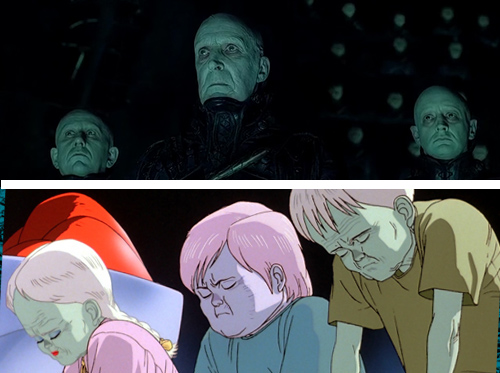 |
We’ve saved this one for last because it illustrates a point about this whole finger-pointing business…
When most cinephiles discover Dark City today (on Netflix or whatever), they think themselves pretty clever, going to parties and asserting that The Matrix totally ripped it off. This assertion, of course, neglects the basic Google search that’d reveal how the two movies were shot in succession, on the same studio lot, using many of the same sets – which therefore makes the whole “timetable of inspiration” rather difficult to reconcile.
Consider this, though…director Alex Proyas has admitted on several occasions that the climactic telepathic duel between John Murdoch and Mr. Book (with all the resultant property damage) was rather heavily inspired by the climatic telekinetic duel between Tetsuo and Kai (with all the resultant property damage) in the Akira manga. The pale, shriveled Strangers of Dark City also bear a striking resemblance to the pale, shriveled espers of Akira. So, surely, that anime/manga must be the creative wellspring from which all these lesser imitators flow?
Well, get this… Akira‘s creator, Katsuhiro Otomo, has freely admitted that his story might be a blatant retelling of an earlier manga, Tetsujin 28 (otherwise known as Gigantor). As in, major characters share the same names. And down and down the rabbit hole, we go….
Bonus. Fist of the North Star = The Road Warrior (Mad Max 2)
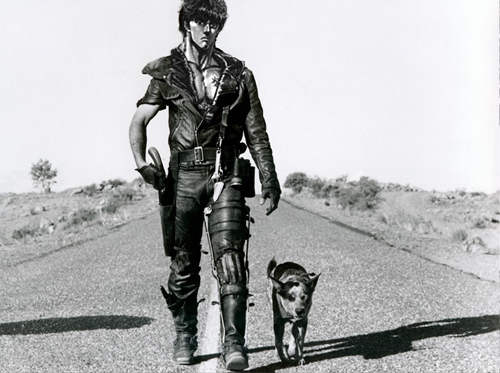 |
And you know what? We’re adding this one to prove another point about the rip-off game…
We can’t, for a minute, pretend that anime has never borrowed from Hollywood (check out Streets of Fire – possibly the inspiration for every anime of the ’80s). Mad Max may not be a Hollywood franchise, per se (close enough though, right?), but you’d have to be dumb, deaf and blind to deny the significant debt owed to it by the seminal shonen series, Fist of the North Star.
Undeniably, mangaka Tetsuo Hara based the entire look of Fist around the aesthetic of The Road Warrior, and then simply replaced Mel Gibson with Bruce Lee for the lead. Dusty old roads, roving gangs of bad dudes with mohawks and shoulder pads, torn-up leather jackets, and brutal violence at every turn. Sure, Max may not have popped as many heads as Kenshiro (who has though, really?), but the two men’s dress, general distaste for lawless killers and that whole “desert messiah” attitude are pretty much one in the same.
The thick, manly eyebrows, martial arts mastery and signature “At-ta-ta-ta-ta-ta-ta-ta!” shriek are all Bruce, though.
Keep in mind, too, that Fist was the top dog shonen series in the early ’80s, sitting on a throne that only juggernauts like Dragon Ball and One Piece have claimed since. It has spawned legions of apprentices and imitators. And none of it would exist without the example set by some weird post-apocalyptic western from Oz.
Previously by Alex Eckman-Lawn:
The 10 Most Diabolical Bosses From Classic Fighting Games
Seven Other Secondary Character Comic-Book Shows That Could Be Made, but Shouldn’t
